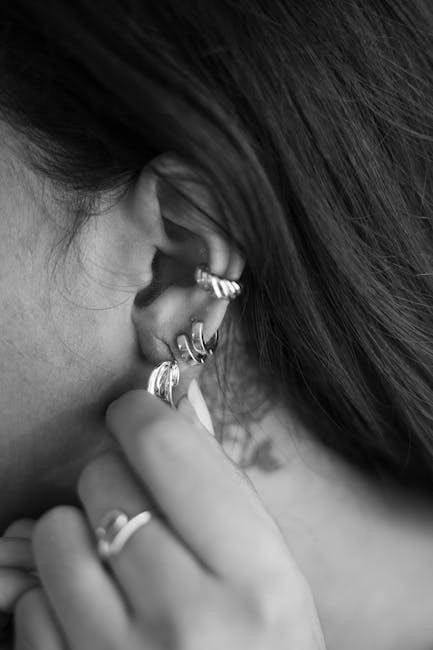Welcome to our essential guide on ear piercing sizes, designed to help you make informed decisions․ Discover the importance of gauge systems, jewelry fit, and comfort for optimal results․
1․1 Overview of Ear Piercing Sizes
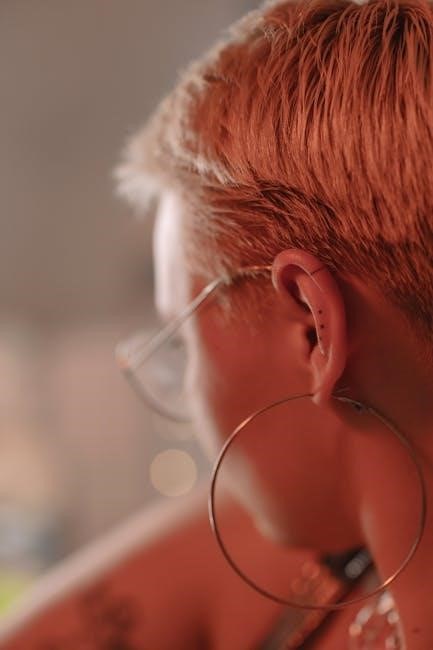
Ear piercing sizes are primarily measured using a gauge system, where lower numbers indicate thicker jewelry․ Common gauges range from 20G (thin) to 14G (thick), with 16G and 18G being popular for cartilage and helix piercings․ The length of the jewelry, such as 6mm or 8mm, is tailored to the individual’s ear shape and piercing type․ Diameters vary to accommodate different ear thicknesses, ensuring comfort and stability․ Standard sizes are widely available, but custom options can be explored for unique fits․ Understanding these measurements helps in selecting jewelry that aligns with personal style and anatomical needs, ensuring both aesthetics and comfort․
1․2 Importance of Choosing the Right Size
Selecting the appropriate size for your ear piercing is crucial for comfort, healing, and aesthetics․ Properly fitted jewelry ensures the piercing heals efficiently, reducing the risk of irritation or complications․ Ill-fitting jewelry, whether too tight or too loose, can lead to discomfort or prolonged healing times․ The right size also enhances the appearance of your piercing, balancing with your ear shape and personal style․ Additionally, suitable sizing prevents jewelry from shifting or causing unnecessary pressure, which can damage the surrounding tissue․ Investing time in understanding your ideal measurements ensures a seamless and satisfying piercing experience, both during the healing process and beyond․
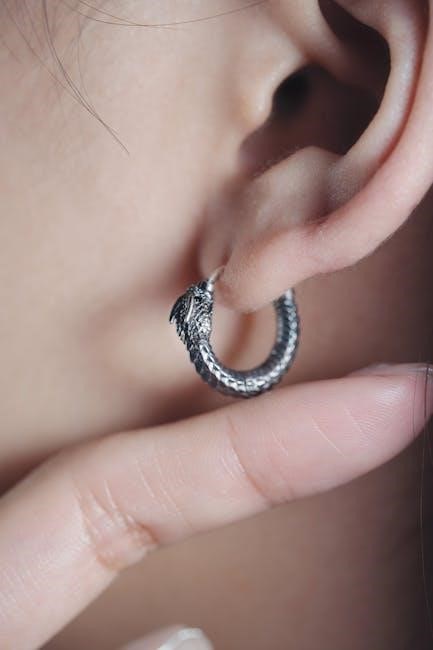
Understanding Ear Piercing Sizes

Ear piercing sizes involve gauge, length, and diameter measurements, ensuring proper fit and comfort․ Understanding these factors helps in selecting jewelry that suits your piercing perfectly․
2․1 Gauge Sizes Explained
Gauge size refers to the thickness of the jewelry used in ear piercings․ It is measured using a numerical scale where lower numbers indicate thicker jewelry (e․g․, 14G or 16G), while higher numbers represent thinner pieces (e․g․, 18G or 20G)․ The gauge system is crucial for ensuring comfort and proper healing, as thicker gauges are generally more stable and less likely to cause irritation․ For example, cartilage piercings often use 16G or 18G, while lobe piercings might use 14G for durability․ Thinner gauges, like 20G, are popular for delicate styles but may not be as secure․ Understanding gauge sizes helps in selecting jewelry that balances aesthetics with comfort and durability, ensuring the best fit for your piercing․
2․2 Length and Diameter Measurements
When selecting ear piercing jewelry, understanding length and diameter measurements is essential for comfort and proper fit․ The length of the jewelry refers to the distance between the ends of the piece, such as the bar in a stud or the diameter of a hoop․ For earlobe piercings, standard lengths typically range from 6mm to 8mm, while cartilage piercings may require shorter lengths, around 4mm to 6mm, depending on the location․ The diameter, or thickness, of the jewelry is often tied to the gauge size, with thicker gauges (lower numbers) offering more stability․ Proper measurements ensure the jewelry sits comfortably without causing irritation or limiting movement․ Choosing the right size is crucial for both aesthetics and healing, as ill-fitting jewelry can lead to discomfort or prolonged healing times․
2․3 Standard vs․ Custom Sizes
Ear piercing jewelry comes in both standard and custom sizes, catering to different needs and preferences․ Standard sizes are widely available and suit most individuals, with common lengths like 6mm for lobes and 4-6mm for cartilage piercings․ These sizes are designed to meet average anatomical requirements, ensuring comfort and compatibility․ Custom sizes, on the other hand, are tailored for unique needs, such as thicker ear tissue or specific piercing placements․ They offer precise fit and aesthetics, ideal for those who require adjustments beyond standard options․ While standard sizes are cost-effective and readily accessible, custom sizes provide personalized comfort and style, making them a worthwhile investment for long-term satisfaction․ Consulting a professional can help determine the best fit for your specific piercing․
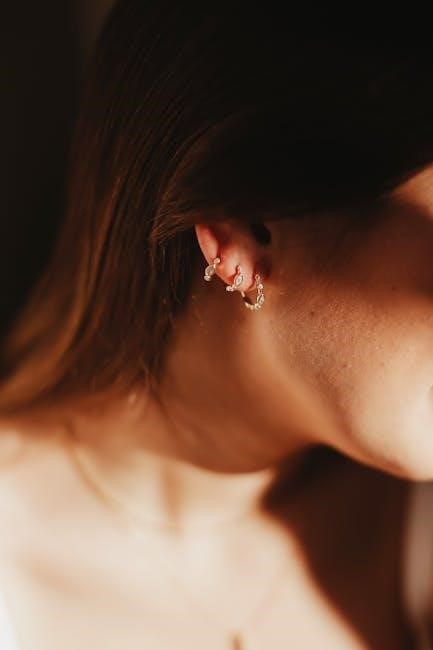
Choosing the Right Jewelry for Your Piercing
Selecting the right jewelry ensures comfort and style․ Consider material, gauge, and length to suit your piercing type․ Proper fit and quality enhance healing and aesthetics․
3․1 How to Measure Your Piercing
Accurate measurement is crucial for selecting the right jewelry․ Use a ruler or calipers to measure the bar length and gauge of your piercing․ For straight bar jewelry, measure the distance between the two ends inside the piercing․ Subtract 2-3mm for comfort․ For curved or circular jewelry, wrap a string or flexible measuring tape around the piercing to determine the diameter․ Gauge size refers to the thickness of the jewelry; use a gauge chart or consult a professional to ensure accuracy․ Proper measurement ensures a comfortable and secure fit, preventing discomfort or migration․ Always consider the type of piercing (e․g․, lobe, cartilage) when determining size․ For new piercings, allow for swelling before finalizing jewelry size․ Professional guidance is recommended for precise measurements and optimal results․
3․2 Selecting Jewelry Based on Face Shape
Your face shape plays a significant role in choosing flattering ear jewelry․ Oval faces can pull off most styles, while round faces benefit from longer earrings to elongate the silhouette․ Square faces look best with soft, curved designs to balance angular features․ Heart-shaped faces should opt for earrings that draw the eye downward․ Consider the proportions of your face and the size of your features when selecting jewelry․ Larger faces can handle bold, oversized pieces, while smaller faces look better with delicate styles․ The goal is to create harmony between your jewelry and natural appearance, enhancing your unique beauty․ Choose designs that complement your face shape for a polished, cohesive look that boosts confidence and style․
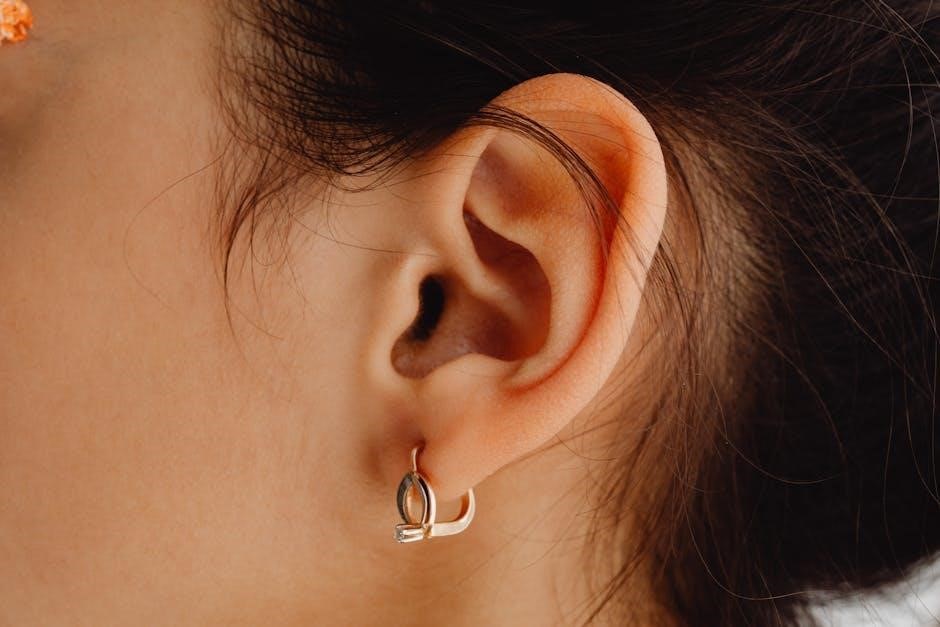
Aftercare and Size Considerations

Proper aftercare ensures healing and comfort․ Choose jewelry that fits well, avoiding tight styles that restrict airflow․ Keep the area clean to promote healing and prevent complications․
4․1 Hygiene Practices for Healing
Proper hygiene is crucial for healing ear piercings․ Clean the area with saline solution daily to prevent infections․ Avoid harsh chemicals or submerged water․ Gently wipe with a clean cloth, and avoid touching the piercing unnecessarily․ Jewelry should be handled with clean hands to minimize bacteria transfer․ Healing times vary, but consistent care ensures optimal results․ Avoid tight jewelry that restricts airflow, as this can slow healing․ Keep the area dry and avoid irritating products․ If irritation occurs, consult a professional for advice․ Proper hygiene practices promote faster healing and prevent complications․
Popular Types of Ear Piercings
Explore the most popular ear piercings, including lobe, helix, cartilage, and more․ Each offers unique styling options, catering to diverse preferences and aesthetic goals․
5․1 Lobe, Helix, and Cartilage Piercings
Lobe piercings are the most common, typically using 16G or 14G needles for thicker lobes, while helix and cartilage piercings often use 16G, 18G, or 20G․ Helix piercings, located on the upper rim of the ear, are popular for their versatility, often featuring small rings or studs․ Cartilage piercings, including conch and tragus, are known for their edgy appeal and usually require slightly longer healing times․ Each type offers unique styling options, with lobe piercings suiting studs or hoops, helix piercings favoring delicate rings, and cartilage piercings complementing bold designs․ Understanding the right gauge and jewelry size ensures comfort and a polished look, making these piercings timeless choices for personal expression․
5․2 Jewelry Recommendations for Each Type
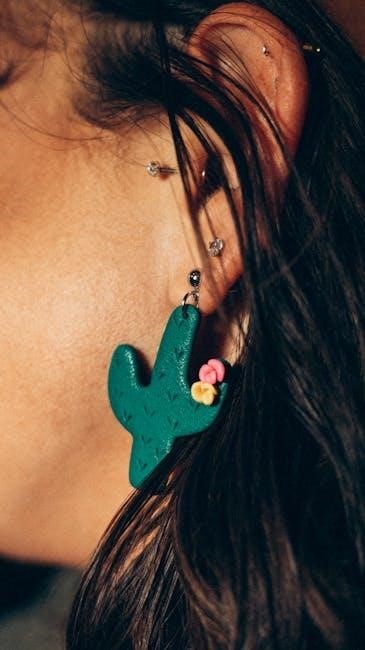
Lobe piercings are versatile and can accommodate studs, hoops, or dangle earrings․ For helix piercings, delicate rings or threader earrings are ideal, while cartilage piercings look stunning with minimalist studs or small hoops․ Jewelry size should align with the piercing’s gauge, ensuring comfort and stability․ For example, 16G or 18G jewelry works well for lobes, while helix and cartilage piercings often use 18G or 20G․ Consider the length of barbell or ring to avoid discomfort․ Thicker jewelry provides stability, aiding healing, but avoid overly large pieces․ Choose materials like surgical stainless steel or titanium for hypoallergenic properties․ Properly sized jewelry enhances the piercing’s appearance and ensures long-term comfort, making it essential to select styles that complement both the piercing type and personal aesthetic․
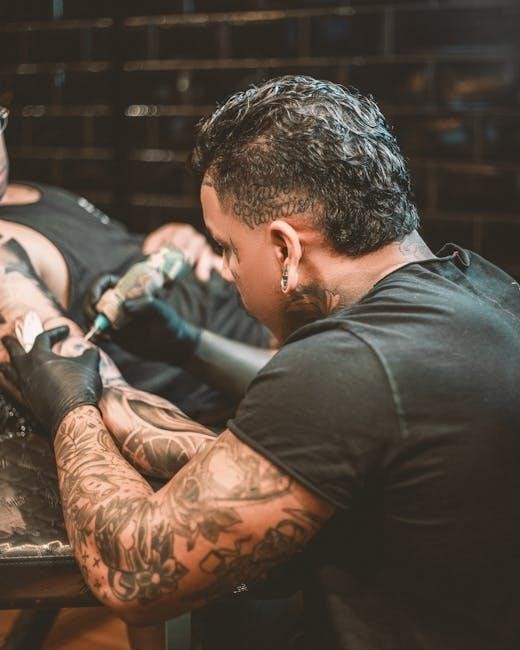
Frequently Asked Questions
Common concerns include determining the right size, understanding gauge systems, and ensuring comfort․ FAQs also cover healing processes and jewelry material options for optimal results and aesthetics․
6․1 Common Concerns About Size and Fit
One of the most common concerns is choosing the correct gauge size, as a smaller gauge may feel too tight, while a larger gauge might appear unstable․ Jewelry length and diameter are also critical, as pieces that are too short or too long can cause discomfort or irritation․ Proper fit is essential for healing, as ill-fitting jewelry can lead to swelling or prolonged recovery․ Many individuals worry about the visibility of their piercings, balancing aesthetics with comfort․ Additionally, determining whether to opt for standard or custom sizes often sparks questions․ Addressing these concerns requires understanding personal anatomy, lifestyle, and desired outcomes․ Consulting a professional or using detailed size guides can help alleviate these worries, ensuring a seamless and satisfying piercing experience․
6․2 Pain and Healing Process
The pain experienced during an ear piercing varies depending on the individual and the type of piercing․ Lobe piercings are generally less painful, while cartilage or helix piercings may cause more discomfort due to the thicker tissue․ The healing process typically ranges from a few weeks to several months, with proper aftercare being crucial for preventing complications․ Keeping the area clean, avoiding tight jewelry, and refraining from playing with the piercing can significantly reduce healing time․ Some people may experience swelling or redness, but these usually subside with time․ It’s important to follow professional advice to ensure a smooth recovery․ While pain is subjective, most find the process manageable, and the end result is well worth the temporary discomfort․
